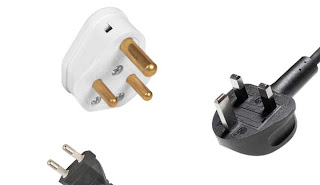Sometimes while working on a laptop, if you see that the battery charge of the laptop has dropped below 20%, naturally you will look for a charger. Similarly, even if the smartphone reaches the end of its charge, you will need a charger.
But have you ever wondered why the chargers of the two devices look so different? Especially where the laptop charger has three pins, why two pins on the phone charger?
When such questions arise in the mind, many people assume that since laptops require more power, more pin chargers are used.
But the answer to the question is not so straightforward.
If we want to know why different types of pin plugs are used, we first need to know what the pins actually do. Also understand why some devices use 3 pin plug and some devices use 2 pin plug.
But before that, let’s consider how the electricity connection started to reach our homes.
How The Electricity Connection Reached The House
The use of electricity is so deeply integrated into our daily lives that we often don’t realize how amazing a technology it is.
The electricity we use is usually produced by using coal, oil, wind or other energy sources. In this way, we use the energy obtained from nature to do everything from washing clothes, ironing, toasting bread for breakfast to drying hair.
Electrical appliances which were unimaginable to us even a few years ago, are now readily available.
American inventor and entrepreneur Thomas Alva Edison was the first to realize that it is possible to use electricity at an affordable price in various tasks of daily life.
In Edison’s time, the electric lamp could only provide light for a few minutes. So Edison developed lamps whose filaments were kept in vacuum chambers. By doing this, the lamp starts giving light for a long time.
After the invention of the modern electric lamp, Edison established the power plant, so that electricity could be delivered to people’s homes. This power plant named ‘Pearl Saint Plant’ was located in New York City. From this center 110 volt direct current (DC electricity) or unidirectional electricity was supplied.
If you know anything about electricity, you might know that DC electricity is not very useful for running household electrical appliances. Because of the resistance in the wire, DC electricity cannot be transmitted at a greater distance from the power plant.
Serbian-American engineer Nikola Tesla found a solution to this problem.
In 1887, Tesla patented the system based on alternating current (AC electricity). He thought that this new power system could solve the problems that DC electricity had.
But Edison did not agree with Tesla’s claim. As a result, the conflict that started between these two researchers, later became known as the ‘electric war’, ‘electricity fight’ or in English as ‘War of the Currents’ (War of the Currents).
However, Tesla eventually won the battle, when he harnessed the mechanical power of Niagara Falls to generate AC electricity. And send this generated electricity to homes hundreds of miles away.
The Westinghouse Company, owned by American engineer and entrepreneur George Westinghouse, bought the patent from Tesla. Westinghouse thought that in the future this AC electricity would become the way to transmit electricity over long distances.
Their hypothesis later proved to be correct and profitable.
Meanwhile, as electricity reached homes, other devices besides the electric lamp began to be invented. Then the new question comes to the fore, how can this electricity be used to run other devices apart from electric lamps?
How can we do our daily tasks more easily using electricity?
The Invention Of The Plug
Inventors came up with different ways to connect electrical appliances used in homes. But all these methods were quite unsafe.
Not only did those early systems run the risk of equipment damage, but users were also at great risk of accidents.
So to solve this problem in 1904, Harvey Hubble designed the ‘separate attachment plug’ to connect separately. His aim was to avoid the danger of electrical wires.
He later improved this design and invented a plug that had two different parts. One part of this new plug he invented was inside the socket. And the other part is a two-pin plug located separately outside the socket.
This was the original design of the 2 pin plug we use today.
In 1928 Philip F Labre designed a 3-pin plug. This new plug replaces the old 2-pin plug. Or it can be said that these 3-pin plugs are proven to ensure safety in household work.
Now the question may arise, what does the pin of the plug actually do?
Now let’s find that answer.
What Is The Function Of PIN?
A typical 2-pin plug has one pin connected to the electrical conductor. On the other hand, the other is connected to a neutral wire.
Electricity flows to the equipment through conductive wires. Neutral, on the other hand, carries its unused power from the device back into the circuit.
The 2-pin plug design has several safety risks. If excess current flows through this plug, the current will seek an alternative path to escape. And the path of least resistance, the current flows. This is called the “Path of Least Resistance” or “Path of Least Resistance”.
Now if the path of least resistance is the human body, then the risk is created.
That is, if a two-pin plug short-circuits, the path through the person holding the plug is the path of least resistance. Or, electricity finds its way through the person. This gives the person an electric shock which can be very fatal.
To avoid this condition, a third pin, called the grounding pin, is often added to the plug. As the name suggests, the function of this pin is to transfer excess current to the ground, so that any hazard can be easily avoided.
It is understood that it is more reasonable to use a 3-pin plug instead of 2-pin to avoid the risk of electricity consumption. So the question is, why is the charger of small devices like mobile still 2 pin?
Why Mobile Phone Charger 2 Pin?
Modern mobile phone chargers are designed to withstand any short circuit. Also, these chargers do not consume much electricity, which can cause accidents.
However, more caution is required in the manufacture of laptop chargers. Because running a laptop requires more electricity.
Basically, we can safely run various small electrical appliances using 2 pin plugs. However, the 3-pin plug cannot provide the protection that a 2-pin plug can provide when running devices that require more power.


